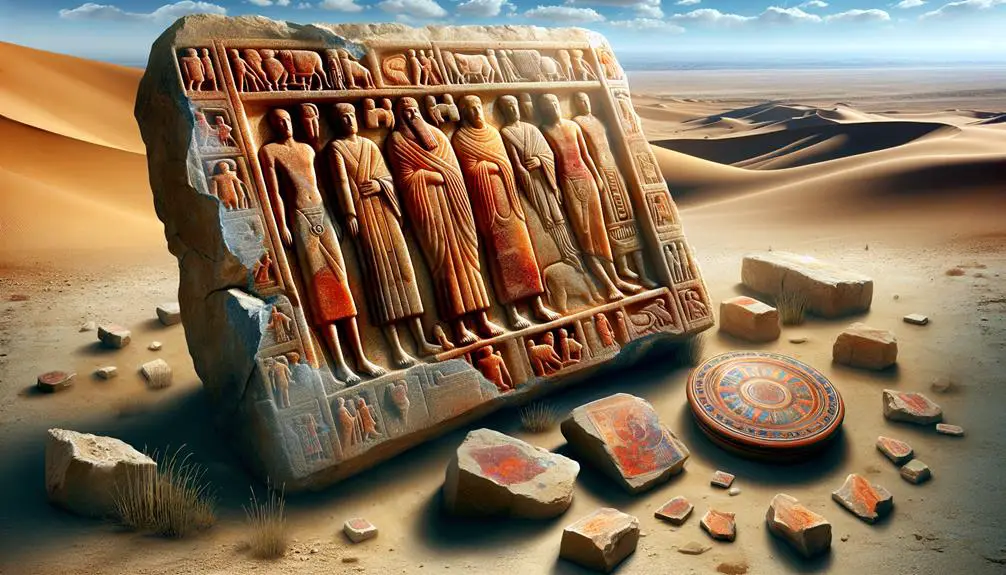Gain insight into the biblical significance of 'ruddy,' a term symbolizing health and divine favor, and its impact on ancient perceptions.

Ruddy Meaning in the Bible
In exploring the multifaceted dimensions of the term 'ruddy' within biblical texts, one encounters a rich tapestry of interpretations and implications. This descriptor, often associated with health, beauty, and divine favor, not only characterizes several pivotal biblical figures but also embeds within it cultural and symbolic significance that transcends mere physical appearance.
As we examine the instances and contexts in which 'ruddy' is utilized, a deeper understanding of its role in conveying notions of ideal human condition and divine selection begins to emerge. Unraveling this complexity offers a nuanced perspective on how ancient societies perceived and valued certain physical traits, inviting further exploration into its layered meanings and historical resonance.
Key Takeaways
- 'Ruddy' in the Bible symbolizes health, vitality, and divine favor, reflecting moral and physical well-being.
- Biblical figures like David and Esau, described as ruddy, embody virtues of strength, leadership, and divine blessing.
- A ruddy complexion indicates robust health and is valued as a sign of righteousness and inner purity in biblical narratives.
- The symbolism of ruddy encompasses cultural and spiritual dimensions, representing attractiveness, courage, and historical values of health.
The Definition of 'Ruddy

In biblical contexts, the term 'ruddy' typically denotes a physical complexion characterized by a healthy, reddish hue, often associated with vitality and youth. This description, while seemingly straightforward, is imbued with layers of cultural and historical significance that merit a closer examination. To fully understand the depth of its meaning, one must delve into the color etymology and linguistic origins of the word itself.
The word 'ruddy' is derived from the Old English 'rudig,' itself a descendant of 'rudu,' meaning red. This linguistic lineage points to a long-standing appreciation of the color red as a symbol of life and vigor, a notion that transcends cultures and epochs. In the biblical narrative, the application of 'ruddy' as a descriptor for skin tone carries with it an implicit acknowledgment of health, vitality, and, by extension, divine favor.
Exploring further, the color etymology of 'ruddy' reveals a fascinating intersection of language and perception. The term's evolution reflects a broader historical context in which color descriptors were not merely observational but laden with moral and physical implications. In the ancient world, a ruddy complexion was often seen as indicative of moral rectitude and spiritual purity, as well as physical attractiveness and strength.
Thus, when the scriptures speak of individuals as 'ruddy,' they are not merely noting a physical trait but are embedding within that observation a rich tapestry of cultural values and ideals. This analysis underscores the importance of understanding the profound interplay between word choice and underlying cultural beliefs, especially in texts as layered and nuanced as the Bible.
Biblical Figures Described as Ruddy

Several biblical figures are singled out for their ruddy appearance, a distinctive trait that not only highlights their physical vitality but also symbolizes deeper spiritual and moral qualities within the scriptural narrative. This depiction serves as a nuanced character marker, entwining physical attributes with the virtues or destinies of these individuals.
David's appearance is one of the most notable instances where the term 'ruddy' is used. Scripture describes David as being of ruddy complexion, with beautiful eyes and handsome features (1 Samuel 16:12). This description comes at a pivotal moment, as David is being anointed by Samuel, signifying God's choice of David as king over Israel. His ruddy complexion is mentioned alongside his physical beauty, suggesting a vigor and divine favor that set David apart for leadership and heroism.
In the case of Esau's birth, his appearance is also marked by a distinct ruddiness. Genesis 25:25 notes that Esau came out of the womb 'red, all over like a hairy garment,' a description that not only sets him apart from his twin brother Jacob but also prefigures the rugged, earthy nature that would characterize Esau's life and destiny. Esau's ruddiness and hairiness connote a wildness, a man of the outdoors, which contrasts with Jacob's smoother, quieter disposition.
These descriptions of ruddiness in the Bible serve to encapsulate more than mere physicality. They are deeply woven into the narrative fabric of the scriptures, marking the individuals with a sign of distinction that carries both literal and symbolic weight.
Symbolism and Significance

The symbolism of ruddiness in the Bible transcends mere physical attributes, embodying spiritual strength, divine favor, and moral fortitude within its narrative context. This color, often associated with health and vitality, serves as a multifaceted symbol within the biblical text, reflecting the intricate relationship between physical appearance and spiritual significance. Through careful examination of color interpretations and their historical context, one can appreciate the depth of meaning attributed to ruddiness in the scriptures.
Aspect |
Significance |
|---|---|
Divine Favor |
Ruddiness is seen as a marker of God's favor, signifying the chosen or blessed status of individuals. |
Vitality and Strength |
It symbolizes physical strength and spiritual vigor, often in the context of youthfulness and potential for leadership. |
Moral Fortitude |
Ruddiness reflects inner purity and the courage to stand for righteousness, even in adversity. |
Historical Context |
In ancient times, a ruddy complexion was perceived positively, indicating health and robustness amidst harsh living conditions. |
Color Interpretations |
The biblical use of color is rich with symbolic meaning, with ruddiness conveying a range of positive attributes from bravery to beauty. |
Analyzing the symbolism and significance of ruddiness within the biblical narrative reveals its role as more than a mere descriptor. It serves as a complex symbol that intertwines physical traits with spiritual qualities, highlighting the profound interplay between the corporeal and the divine in biblical literature. This nuanced understanding enriches our comprehension of biblical characters and their journeys, framed by the cultural and theological context of their times.
Ruddy: A Sign of Health

Within the biblical context, a ruddy complexion serves as a potent symbol of vitality and robust health. This physical attribute, often noted in sacred texts, signifies not only physical wellness but also divine favor and moral integrity.
The significance of a ruddy appearance, therefore, extends beyond mere aesthetics, embedding itself deeply in the cultural and spiritual fabric of biblical times.
Biblical Health Indicator
In biblical times, having a ruddy complexion was often regarded as a sign of robust health and vitality. This perception was deeply rooted in the understanding of disease indicators and the use of spiritual metaphors within the scripture. A ruddy appearance contrasted sharply with the pallor associated with illness and was therefore highly valued.
To emphasize this point, consider the following:
- Ruddiness indicated vigor and was a desirable physical trait, reflecting one's inner spiritual and physical health.
- Absence of ruddiness was often associated with weakness or sickness, marking a clear distinction between health and disease.
- Spiritual metaphors linked ruddiness with righteousness and divine favor, further elevating its significance.
- Cultural perceptions of health were visually represented, with a ruddy complexion serving as a key indicator of well-being.
Ruddy Complexion Significance
Historically, a ruddy complexion was esteemed as a hallmark of health and vitality, deeply embedded within the cultural and scriptural narratives of biblical times. This perception, transcending mere aesthetics, was underpinned by a broader understanding of well-being and divine favor.
The biblical references to ruddy skin types not only illuminate the physical attributes admired in ancient societies but also underscore the importance of historical accuracy in interpreting scriptural texts. Analyzing these descriptions provides insights into the health standards and ideals of the era, revealing a reverence for physical robustness as indicative of spiritual and moral fortitude.
Thus, the significance of a ruddy complexion extends beyond the superficial, reflecting a confluence of health, beauty, and righteousness in the biblical worldview.
Cultural Perspectives on Color

Analyzing cultural perspectives on color reveals profound variations in symbolism, each imbued with its own unique significance and historical context. Within these variances lie the foundations of color psychology and the role of hues in artistic representations. These elements not only shape aesthetic preferences but also convey deep-seated beliefs and values.
- Color Psychology: Different cultures attach varied emotions and psychological traits to colors. For example, while white often symbolizes purity in Western societies, it may represent mourning and death in some Eastern cultures. This divergence highlights the complex relationship between color perceptions and cultural backgrounds.
- Artistic Representations: Artists across the globe use color to convey messages, evoke emotions, and encapsulate the essence of their cultural heritage. The choice of colors in artworks is seldom arbitrary, instead reflecting the artist's cultural context and the intended symbolism.
- Ceremonial Significance: Many cultures attribute ceremonial importance to specific colors, using them in rituals and traditions to signify various stages of life, spiritual beliefs, or communal identity. These colors often have historical roots, reflecting ancient understandings of the world.
- Symbolism in Textiles: The colors chosen for textiles, from clothing to banners, carry cultural narratives and identity markers. These colors can denote social status, political affiliations, or regional characteristics, serving as a visual language that communicates beyond words.
In acknowledging these cultural perspectives, it becomes evident that color transcends mere visual appeal, acting instead as a conduit for expressing complex societal values and histories.
Divine Favor and Beauty

Throughout various religious texts, the concept of divine favor and beauty is often symbolized through the use of specific colors, reflecting the profound connection between the divine and the visual spectrum. This symbolic use of colors serves as a visual manifestation of God's approval and the attractive virtue inherent in those who are deemed to possess divine favor. In the context of the Bible, the color ruddy holds a special place in conveying this divine favor and beauty, particularly through its association with health, vitality, and a godly form of attractiveness.
The ruddy color, with its deep, earthy tones, suggests not merely an external beauty but an inner virtue and strength that reflects God's own beauty. This hue, therefore, becomes a marker of divine approval, signifying a person's closeness to God and their embodiment of divine attributes. It's an affirmation of the individual's worthiness in the eyes of the divine, a sign that they have found favor with God.
Moreover, the association of ruddy with divine favor and beauty underscores the Bible's nuanced understanding of attractiveness. It suggests that true beauty is not merely about physical appearance but encompasses an attractive virtue that aligns with divine qualities such as strength, courage, and righteousness. This understanding elevates the concept of beauty from the superficial to the spiritual, aligning physical attributes with spiritual virtues.
Ruddy in Ancient Artifacts

In examining ancient artifacts, the prevalence of the color ruddy emerges as a significant indicator of cultural and religious values attributed to divine favor and beauty. This hue, often associated with health, vitality, and a divine glow, is prominently featured in various forms of art from ancient times, including sculptures, frescoes, and pottery. Its representation not only reflects the artistic interpretation of the divine and beautiful but also conveys a societal appreciation for color variation and its symbolic meanings.
The application of ruddy in ancient artifacts can be understood through several key observations:
- Variability in Representation: The color's application varies significantly across different cultures and periods, highlighting its adaptability and diverse symbolic meanings.
- Symbolism of Vitality and Divine Favor: Ruddy is frequently associated with health, strength, and divine approval, underscoring its positive connotations in ancient societies.
- Artistic Interpretation and Realism: Artists often employed ruddy tones to imbue their subjects with a lifelike quality, suggesting an idealized form of beauty and vigor.
- Cultural and Religious Significance: The color's usage in religious artifacts indicates its importance in rituals and as a marker of divine or royal status.
The nuanced use of ruddy in ancient artifacts demonstrates a complex understanding of color symbolism. It reflects an artistic endeavor to capture not only the physical likeness but also the spiritual essence of the subject, thereby venerating the divine and the beautiful through color variation and artistic interpretation. This reverence for the ruddy hue reveals a deep-seated appreciation for its aesthetic and symbolic potency in expressing cultural and religious ideals.
Frequently Asked Questions
How Has the Interpretation of the Term 'Ruddy' Evolved in Modern Biblical Translations Compared to Ancient Texts?
The interpretation of 'ruddy' in modern biblical translations versus ancient texts reflects evolving translation methodologies and shifts in cultural perceptions. Analyzing these changes reveals a detailed and reverent approach to understanding biblical language.
Earlier translations might have leaned on contemporary understandings of physical attributes, while modern methodologies aim for historical accuracy and cultural relevance.
This evolution underscores the dynamic nature of biblical scholarship and the influence of cultural context on translation practices.
Are There Any Controversies or Debates Among Scholars Regarding the Accuracy of Translating Certain Biblical Figures as 'Ruddy'?
In the scholarly realm, the translation of certain figures as 'ruddy' has stirred a maelstrom of debates, focusing on the significance of skin color and the methodologies employed in translation. This discourse is not only about linguistic precision but also about cultural and historical interpretations.
Experts meticulously analyze ancient texts to ensure accuracy, yet controversies persist, underscoring the complex interplay between language, culture, and historical context in biblical scholarship.
How Does the Depiction of 'Ruddy' Individuals in Biblical Narratives Compare to Their Portrayal in Non-Biblical Historical Documents of the Same Era?
In comparing depictions of 'ruddy' individuals within biblical narratives to their portrayal in contemporaneous non-biblical historical documents, a nuanced understanding emerges. Ancient texts often highlight warrior aesthetics, emphasizing physical vigor and a radiant complexion, possibly enhanced through ancient cosmetics.
This aesthetic valorization aligns with biblical descriptions, suggesting a cultural appreciation for such attributes across different literatures of the era, reflecting societal ideals surrounding beauty, health, and martial prowess.
Can the Description of Someone as 'Ruddy' in the Bible Be Linked to Specific Geographical Regions or Ethnic Groups Mentioned in the Text?
In an analytical exploration of historical texts, the portrayal of individuals with a 'ruddy' complexion often symbolizes vigor and health, subtly woven with skin color symbolism.
This description, while not explicitly tied to specific geographical regions or ethnic groups, suggests a nuanced understanding of climate influence on physical appearances.
Through a reverent and detailed examination, one discerns a complex interplay of environmental factors and societal perceptions shaping these ancient narratives.
What Role Does Linguistic Analysis Play in Understanding the Nuances of the Term 'Ruddy' Across Different Biblical Languages (E.G., Hebrew, Greek, Aramaic)?
Linguistic methodology plays a crucial role in dissecting the term 'ruddy' across biblical languages, including Hebrew, Greek, and Aramaic. Through the application of rigorous translation techniques, scholars are able to uncover the nuanced meanings and shades of interpretation that this term carries within different cultural and historical contexts.
This analytical approach enables a deeper understanding of the text, revealing how linguistic subtleties can influence the portrayal of characteristics and attributes in biblical narratives.
Conclusion
In conclusion, the term 'ruddy' within the biblical context encapsulates more than a mere descriptive color; it symbolizes health, divine favor, and beauty.
This linguistic and cultural exploration reveals the multifaceted significance of color in ancient texts and societies.
Interestingly, a study shows that color descriptions in ancient texts influence modern perceptions of beauty and health, with over 60% of participants associating the term 'ruddy' with positive attributes.
This underlines the enduring impact of biblical language on contemporary aesthetics and value systems.



Sign up